
The Four Thirds System is a standard created by Olympus and Eastman Kodak for digital single-lens reflex camera (DSLR) design and development. Four Thirds refers to both the size of the image sensor (4/3") as well as the aspect ratio (4:3). The Olympus E-1 was the first Four Thirds DSLR, announced and released in 2003. In 2008, Olympus and Panasonic began publicizing the Micro Four Thirds system, a mirrorless camera system which used the same sensor size; by eliminating the reflex mirror, the Micro Four Thirds cameras were significantly smaller than the Four Thirds cameras. The first Micro Four Thirds cameras were released in 2009 and the final Four Thirds cameras were released in 2010; by that time, approximately 15 Four Thirds camera models had been released by Olympus and Panasonic in total. The Four Thirds system was quietly discontinued in 2017, six years after the final cameras were released.

Nikkor is the brand of lenses produced by Nikon Corporation, including camera lenses for the Nikon F-mount.

Macro photography is extreme close-up photography, usually of very small subjects and living organisms like insects, in which the size of the subject in the photograph is greater than life-size . By the original definition, a macro photograph is one in which the size of the subject on the negative or image sensor is life-size or greater. In some senses, however, it refers to a finished photograph of a subject that is greater than life-size.

Sigma Corporation is a Japanese company, manufacturing cameras, lenses, flashes and other photographic accessories. All Sigma products are produced in the company's own Aizu factory in Bandai, Fukushima, Japan. Although Sigma produces several camera models, the company is best known for producing high-quality lenses and other accessories that are compatible with the cameras produced by other companies.

The Pentax K-mount, sometimes referred to as the "PK-mount", is a bayonet lens mount standard for mounting interchangeable photographic lenses to 35 mm single-lens reflex (SLR) cameras. It was created by Pentax in 1975, and has since been used by all Pentax 35 mm and digital SLRs and also the MILC Pentax K-01. A number of other manufacturers have also produced many K-mount lenses and K-mount cameras.

The Sigma 30mm f/1.4 EX DC HSM is a wide-aperture photographic lens made by the Sigma Corporation, equipped with a Hyper Sonic Motor. The lens was produced in Canon EF mount, Four Thirds System, Nikon F-mount, Pentax K mount, the SA mount, and the Sony/Minolta AF Mount varieties, all of the same optical formula. It shipped with a removable petal-type lens hood. The lens assumes a crop factor of roughly 1.5, and therefore is not usable with on full-frame or 135 film cameras.
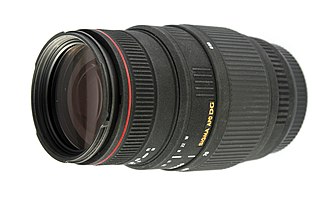
The Sigma 70-300mm F4-5.6 APO DG Macro lens is a consumer-level, telephoto zoom lens made by Sigma Corporation. Different versions of this lens are produced that work with cameras from Canon, Nikon, Pentax, Konica Minolta, Sony and Sigma. Additionally, Olympus' 70–300 f/4–5.6 lens for Four-Thirds has the same optical design and specifications as this lens. The lens is packaged with a lens hood.

The Sigma 50mm f/1.4 EX DG HSM is a normal prime lens made by the Sigma Corporation.
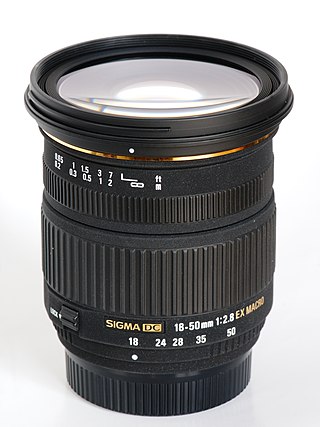
The Sigma 18-50mm f/2.8 EX DC Macro is a wide to normal angle, zoom lens made by the Sigma Corporation.

The Sigma 12-24mm f/4.5-5.6 EX DG HSM is a professional-level wide-angle zoom lens made by Sigma Corporation. At launch it was the widest rectilinear lens available for full-frame 35mm SLR cameras, providing a field of view of 122 degrees. It has since been surpassed by the Canon EF 11-24mm f/4L zoom lens and the Irix 11mm f/4, a manual focus prime lens. The Sigma 12-24 has low distortion even compared to less wide zooms like the Canon EF 16-35mm lens.

The Sigma APO 120-400mm F4.5-5.6 DG OS HSM lens is a super-telephoto lens produced by Sigma Corporation. It contains three SLD glass elements to provide correction for chromatic aberration. It is aimed toward advanced consumers.

The Sigma APO 150-500mm F5-6.3 DG OS HSM lens is a super-telephoto lens produced by Sigma Corporation. It contains three SLD glass elements to provide correction for chromatic aberration. It is aimed toward advanced consumer level photographers, and is available in Nikon, Canon, Pentax and Sigma camera mounts.

The Sigma APO 180mm F3.5 EX DG lens was a telephoto/macro lens produced by Sigma Corporation. It contained two SLD glass elements to provide correction for chromatic aberration and was aimed toward advanced consumers.

The Sigma 50-500mm f/4-6.3 EX DG HSM is a super-telephoto zoom lens produced by Sigma Corporation. It is commonly known as the "Bigma" because of its long and heavy body. It contains four SLD glass elements to provide correction for chromatic aberration. It is aimed at advanced consumers.
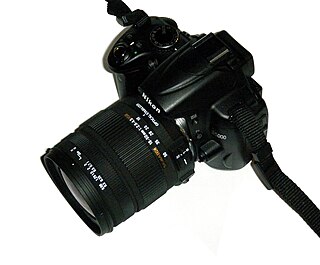
The 18-50mm f/2.8-4.5 DC OS HSM is a wide-angle zoom lens produced by Sigma Corporation. The lens has four different variates, fitting on the Canon EF mount, Pentax K mount, Minolta A-mount, and the Nikon F-mount. It features internal focusing and internal zooming, as well as two SLD elements and three aspherical lenses.
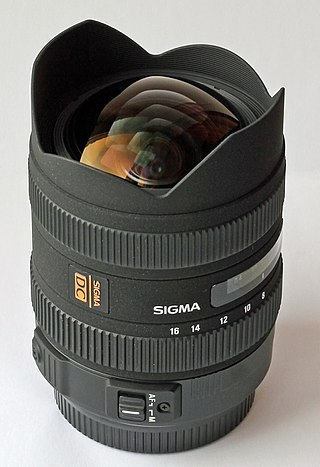
The Sigma 8–16mm lens is an enthusiast-level, ultra wide-angle rectilinear zoom lens made by Sigma Corporation specifically for use with APS-C small format digital SLRs. It is the first ultrawide rectilinear zoom lens with a minimum focal length of 8 mm, designed specifically for APS-C size image sensors. The lens was introduced at the February 2010 Photo Marketing Association International Convention and Trade Show. At its release it was the widest viewing angle focal length available commercially for APS-C cameras. It is part of Sigma's DC line of lenses, meaning it was designed to have an image circle tailored to work with APS-C format cameras. The lens has a constant length regardless of optical zoom and focus with inner lens tube elements responding to these parameters. The lens has hypersonic zoom autofocus.
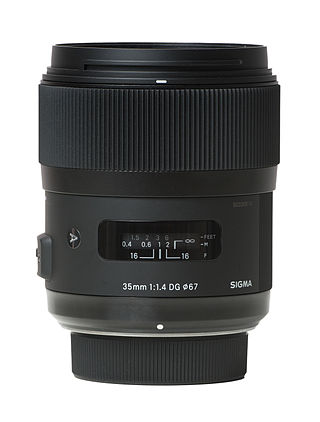
The Sigma 35 mm f/1.4 DG HSM Art is a wide-angle prime lens made by the Sigma Corporation. The lens was announced at the 2012 photokina trade fair.

The Sigma 300 – 800 mm lens is a professional-level supertelephoto zoom lens made by Sigma Corporation from 2005 to 2019 for use with digital SLRs. It is a modification of the non-DG model Sigma 300-800mm F5.6 EX APO IF HSM was being in production in 2003–2005. Due to its massive size and weight, the lens has been nicknamed the "Sigmonster"

The Leica L-Mount is a bayonet mount developed by Leica Camera AG for interchangeable-lens autofocus digital cameras.

























